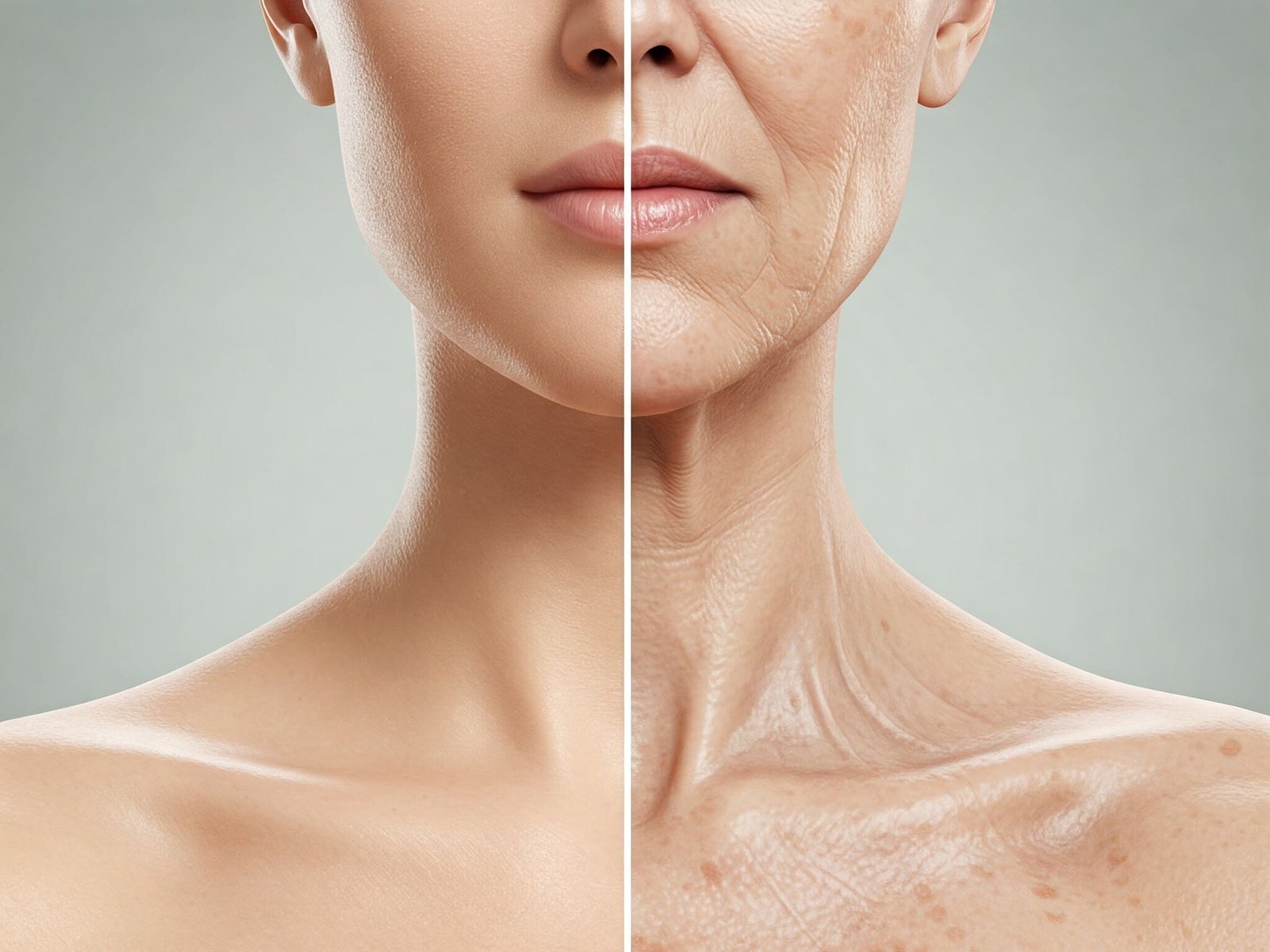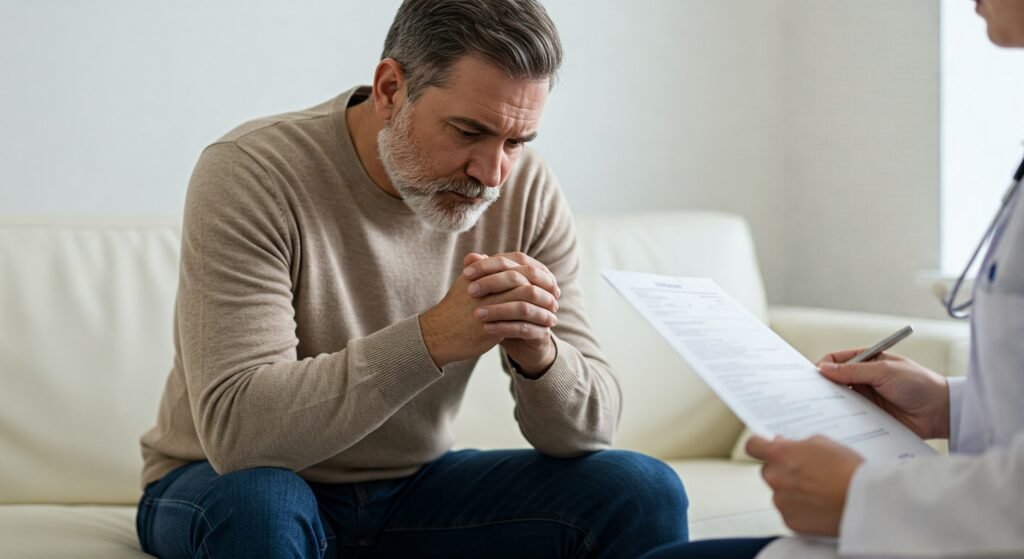
Aging skin is influenced by both intrinsic factors like genetics and extrinsic factors like sun exposure.
Introduction
Did you know that by age 50, the skin’s natural collagen production drops by about 30%, leading to visible signs of aging like wrinkles and sagging? The effects of aging on skin are a natural part of life, but they can significantly alter appearance, texture, and even skin health, making it more prone to damage and disease. This article explores how aging impacts the skin, delving into the biological changes, external factors, and practical steps to mitigate these effects for healthier, more vibrant skin as we age.
The Biology of Aging Skin
Aging skin undergoes significant changes at a cellular level, driven by both intrinsic and extrinsic factors. Intrinsic aging, determined by genetics, begins in our 20s as the skin’s natural repair processes slow down. The production of collagen and elastin—proteins responsible for skin’s firmness and elasticity—decreases by about 1% per year after age 20, according to a 2019 study in Clinical Interventions in Aging.
The epidermis, the outermost layer of skin, thins with age, making it more fragile and less effective as a barrier. Meanwhile, the dermis loses volume as hyaluronic acid and natural oils diminish, leading to dryness and a loss of plumpness. Sebaceous glands also produce less oil, exacerbating dryness, particularly after menopause in women due to hormonal shifts.
These biological changes set the stage for visible signs of aging, such as fine lines, sagging, and a slower healing process. Understanding this foundation helps explain why aging skin looks and feels different over time.
How Does Aging Affect Skin Elasticity and Wrinkles?
One of the most noticeable effects of aging on skin is the loss of elasticity, which leads to wrinkles and sagging. As collagen and elastin fibers break down, the skin loses its ability to “bounce back,” resulting in permanent creases, especially in areas with repetitive movements like the forehead and around the eyes. A 2020 study in Dermatologic Research found that skin elasticity decreases by approximately 20% between ages 30 and 70.
Gravity plays a role as well, pulling on looser skin to create jowls and drooping eyelids. The subcutaneous fat layer beneath the skin also thins, reducing support and making the skin appear more hollow, particularly in the cheeks and under the eyes. This combination of factors makes wrinkles more pronounced over time.
Lifestyle choices can accelerate this process—smoking, for instance, reduces blood flow to the skin, depleting oxygen and nutrients needed for elasticity. Protecting skin elasticity involves both preventive measures and targeted treatments, which we’ll explore later.
What Causes Age Spots and Pigmentation Changes?
Age spots, also known as liver spots, are another common effect of aging on skin, often appearing as flat, brown patches on sun-exposed areas like the face, hands, and arms. These spots result from an accumulation of melanin due to years of UV exposure, which triggers overproduction in melanocytes, the pigment-producing cells. A 2018 study in The Journal of Investigative Dermatology noted that individuals with a history of frequent sun exposure were 40% more likely to develop age spots by age 60.
Aging also slows the skin’s ability to shed dead cells, leading to uneven pigmentation and a dull complexion. Hormonal changes, particularly in women during menopause, can exacerbate conditions like melasma, causing darker patches on the face. Additionally, the skin’s reduced capacity to repair DNA damage from UV rays increases the risk of hyperpigmentation over time.
Preventing age spots starts with sun protection, but treatments like retinoids and chemical peels can help fade existing pigmentation. Addressing these changes can restore a more even skin tone.

How Does Aging Impact Skin Hydration and Dryness?
Aging skin often becomes drier, a direct result of reduced oil production and a weakened skin barrier. The sebaceous glands shrink with age, producing less sebum, the natural oil that keeps skin hydrated. A 2021 study in Skin Research and Technology found that sebum production drops by up to 60% in women after menopause, leading to chronic dryness and flakiness.
The skin’s ability to retain moisture also declines as levels of hyaluronic acid—a molecule that holds water in the skin—decrease. This makes aging skin more prone to irritation, itching, and conditions like eczema. Environmental factors, such as low humidity or harsh soaps, can worsen dryness, creating a cycle of discomfort and damage.
Hydrating the skin through moisturizers with ingredients like ceramides and glycerin can help restore the barrier. Drinking adequate water and using a humidifier in dry climates also support skin hydration.
Why Does Aging Skin Become More Prone to Bruising and Damage?
Aging skin is more susceptible to bruising and damage due to structural changes in its layers. The thinning of the epidermis and dermis, combined with a loss of subcutaneous fat, reduces the skin’s protective padding, making blood vessels more vulnerable to impact. A 2022 study in Dermatology Reports found that skin thickness decreases by about 15% between ages 30 and 80, increasing fragility.
Blood vessels themselves become more brittle with age, and the skin’s slower healing process means bruises and cuts take longer to fade. Reduced collagen also weakens the skin’s tensile strength, making it more likely to tear or develop lesions, especially in older adults. Medications like blood thinners, commonly used in older age, can further increase bruising risk.
Protecting aging skin involves gentle handling, avoiding trauma, and ensuring adequate nutrition to support healing. Vitamin C and zinc, for example, can aid in tissue repair.
What Role Does Sun Exposure Play in Aging Skin?
Sun exposure is the leading extrinsic factor in skin aging, often referred to as photoaging. UV rays penetrate the skin, breaking down collagen and elastin while generating free radicals that cause oxidative stress. A 2019 study in Photodermatology, Photoimmunology & Photomedicine found that up to 80% of visible facial aging signs, like wrinkles and age spots, are attributable to UV exposure.
UVA rays, which penetrate deeper, damage the dermis, while UVB rays cause surface burns and increase the risk of skin cancer. Over time, this damage accumulates, leading to leathery texture, deep wrinkles, and uneven pigmentation. The skin’s ability to repair UV-induced DNA damage also declines with age, compounding the effects.
Daily use of broad-spectrum sunscreen with SPF 30 or higher is the most effective way to prevent photoaging. Wearing protective clothing and avoiding peak sun hours can further reduce damage.

How Does Aging Affect Skin’s Immune Function and Healing?
The effects of aging on skin extend to its immune function and healing capacity, making it more vulnerable to infections and injury. The skin’s immune cells, like Langerhans cells, decrease in number and activity with age, reducing its ability to fight off pathogens. A 2020 study in Immunity & Ageing found that immune cell activity in the skin drops by about 30% after age 65.
Wound healing slows as well, due to reduced blood flow, lower collagen production, and a decline in growth factors needed for tissue repair. This means cuts, scrapes, and even minor infections take longer to heal, increasing the risk of complications like chronic wounds or cellulitis. Aging skin is also more prone to skin cancers, such as basal cell carcinoma, due to cumulative DNA damage and weakened immune surveillance.
Supporting skin health with a nutrient-rich diet, including vitamins A, C, and E, can bolster its immune function. Keeping the skin clean and moisturized also helps prevent infections.
Practical Strategies to Mitigate Aging Skin Effects
While the effects of aging on skin are inevitable, certain strategies can slow their progression:
- Use a daily moisturizer with hyaluronic acid or ceramides to combat dryness and strengthen the skin barrier.
- Apply broad-spectrum sunscreen every day, even on cloudy days, to protect against UV damage.
- Incorporate retinoids or vitamin C serums into your routine to boost collagen production and fade pigmentation.
- Stay hydrated by drinking 8–10 glasses of water daily and eating water-rich foods like cucumbers and oranges.
- Avoid smoking and limit alcohol, as both accelerate collagen breakdown and dehydrate the skin.
- Get 7–8 hours of sleep nightly to support skin repair and regeneration.
- Consider professional treatments like microneedling or laser therapy for more significant aging concerns.
Consistency in these habits can help maintain skin health and reduce visible signs of aging over time.
Addressing Common Challenges in Aging Skin Care
Caring for aging skin can be challenging due to cost, sensitivity, or lack of knowledge about effective products. Affordable options like drugstore moisturizers with proven ingredients (e.g., niacinamide or peptides) can be just as effective as luxury brands. If sensitivity is an issue, patch-test new products and opt for fragrance-free formulas to minimize irritation.
Education is key—many people over-exfoliate or use harsh products, which can damage aging skin further. Focus on gentle cleansing and avoid overusing acids or scrubs, which can strip the skin’s natural oils. Building a simple, sustainable routine tailored to your skin type can make a significant difference.
Aging Skin as a Reflection of Overall Health
The effects of aging on skin are more than skin-deep—they reflect the body’s overall health and resilience. By addressing dryness, protecting against UV damage, and supporting the skin’s natural repair processes, you can maintain a healthier complexion well into later years. A proactive approach to skincare not only improves appearance but also enhances skin function, reducing the risk of injury and disease.
Get Your Doctor’s Approval
Consult your doctor’s approval before beginning any new supplement. Even though they don’t require prescriptions, some supplements may not be safe. Your doctor will ensure there are no potential interactions with your medications or negative side effects.






